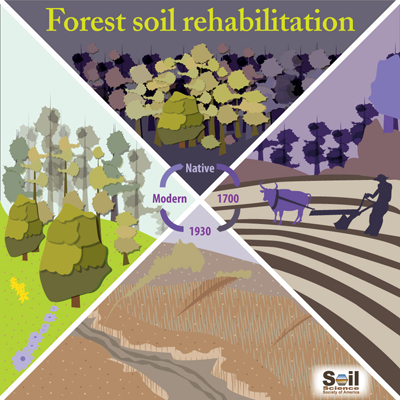Soil Science Society of America
5585 Guilford Road • Madison, WI 53711-5801 • 608-273-8080 • Fax 608-273-2021
www.soils.org
Twitter | Facebook
NEWS RELEASE
Contact: Hanna Jeske, Associate Director of Marketing and Brand Strategy, 608-268-3972, hjeske@sciencesocieties.org
How can we tell if forest rehabilitation is successful?
Nov. 15 2018 – When trees are removed, it’s not just the view that changes in a former woods. The Soil Science Society of America (SSSA) Nov. 15 Soils Matter blog explains the unintended consequences of tree removal by early colonists in Southeastern states, and how the land is recovering.
 In the 1700s, colonists cleared the land of its original hardwood trees to make space for homes and crops. Over the centuries, however, soil erosion and degradation led to the abandonment of these homesteads. What happened?
In the 1700s, colonists cleared the land of its original hardwood trees to make space for homes and crops. Over the centuries, however, soil erosion and degradation led to the abandonment of these homesteads. What happened?
“Healthy soil is a complex mixture of particles, soil microorganisms, and spaces in between that soil scientists call pores,” writes Zach Brecheisen, a doctoral student at Duke University. Brecheisen studies the soils in reforested loblolly pine forests. “Plowing and erosion compacted the soils and destroyed the soil pore structure.” As a result, heavy rains were unable to soak through the soil. The water ran off the surface, eroding the soil as it went.
Furthermore, the crops took up water from the soil differently and released less water to the atmosphere. “That left soggy soil which couldn’t absorb as much water as forest-covered soils,” Brecheisen says. “With each additional rainfall, the problem worsened and erosion increased, washing away topsoils and their nutrients.”
The U.S. Forest Service began to reclaim these lands in the early 1900s and planted loblolly pines. Those pines have now given North Carolina a claim to fame as “the land of the pines.” But have they made other differences?
Researchers have found that, in terms of soil health, progress has been made. “We’ve compared the soils of the loblolly pine forests to hardwood forests and local plowed agricultural soils,” Brecheisen says. They’ve found the proportion of larger pores, coarse organic matter, and roots in the soil “appears to be almost identical between reference hardwood forests and old-field loblolly pine forests.”
That’s good news for the soil, and good news for the forests!
To read the entire blog post, visit https://wp.me/p3Rg6r-pN.
Follow SSSA on Facebook at https://www.facebook.com/SSSA.soils, Twitter at SSSA_Soils. SSSA has soils information on www.soils.org/discover-soils, for teachers at www.soils4teachers.org, and for students through 12th grade, www.soils4kids.org.